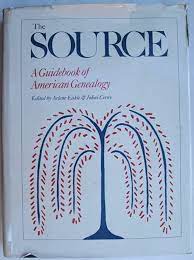Articles/Essays – Volume 18, No. 2
Genealogical Blockbuster | Arlene H. Eakle and Johni Cerny, eds., The Source: A Guidebook of American Genealogy
You don’t have to be consumed with genealogical passion to profit from this new work of far-reaching and fundamental importance, though those who are will buy it as a matter of course and use it extensively. Furthermore, raw beginners and salty old pros alike will find it easy to use and inexhaustible in its benefits. Micheneresque in both title and scope, The Source is an indispensible adjunct to any genealogical project that values thoroughness and efficiency.
This is not a manual of research procedure; that function is to be filled by a companion volume, Ancestry’s Guide to Research, scheduled for later publication (though referred to in The Source as already having appeared). An introductory section deals with basic research procedures and common pitfalls; but the book’s main emphasis is on locating and using the various sources, published and unpublished, available to genealogists. A concluding section, “Special Resources,” deals primarily with records on immigration and ethnic minorities, and seven appendices give cur rent addresses of repositories and publishers useful to genealogists.
In spite of its formidable size, The Source is remarkably easy to use. The re searcher can quickly locate a needed chapter by using an “information guide” at the beginning of each chapter, which gives, in graph form, the type of information contained in the records being considered, a table called “Could You Use This Chapter?” giving the chronological period in which such records were kept, and “Clues That You Should Consult These Records.” Because some of the chapters are very lengthy and all are very detailed, these pages will save the researcher a great deal of time.
Copious illustrations appear, it seems, on almost every page. Facsimile examples of every significant record type are given. The researcher who has never seen a manuscript census schedule, for example, can practice using one, illustrated in this book, before entering a library. The techniques for using some sources, such as the handy Sanborn fire insurance maps, are even less well-known, and the illustrations in such cases are especially welcome. (Note that the Sanborn map illustrated on p. 524 is transposed with the Chicago Archdiocesan record on p. 520.)
It is a further delight that, wherever possible, the illustrations have been selected for their human interest as well. Consider, for example, the Civil War pension application of L. H. Hathcock reproduced in full on pp. 285-91. Hathcock was wounded in the thigh during the battle of Murfreesboro and lost the use of his leg, which rendered him barely able to support his wife and three children. “I am trying to farm,” he wrote. “With the help of my wife and children I can barely make a living. My neighbors are good to me and help me some.”
Some of the illustrations go beyond the bare requirements of the text. In William Thorndale’s chapter, “Land and Tax Records,” there is a fascinating set of instructions (p. 221) on “Drawing Plat Maps.” No doubt such instructions are not strictly necessary to Thorndale’s purpose of teach ing the use of land records, but they are most welcome nevertheless, and enrich the researcher’s experience. Knowing how the sources are created helps us use them intelligently.
As nationally known and respected professional genealogists, the editors, Arlene Eakle and Johni Cerny, are understandably intolerant of typical genealogical frauds and failings such as bogus pedigrees and unauthenticated records. Likewise, they value the pursuit of genealogical truth wherever it may be found. Few of us would prefer to find an ancestor in a divorce court record, an indigent list, or a penitentiary roster, but Eakle and Cerny give detailed instructions for searching all of those sources. Genealogy as an ego-flattering enterprise will find no encouragement here, but seekers after unvarnished genealogical truth will be well armed.
Eakle and Cerny are prominent contributors as well as editors: Eakle’s chapter on “American Court Records” is a real tour de force that could stand alone as a mono graph, and Cerny’s chapters on institutional records and ethnic minorities are, as far as I know, the first published descriptions of these records. The other authors are all impressively credentialed experts in specific research areas.
Ancestry Publishing Co. is a newcomer to the publishing scene. The Source is the firm’s first book, and plans include publication of other books as well as expansion of its quarterly newsletter into a bi-monthly newsletter and a magazine.
The Federation of Genealogical Societies recently bestowed a special Award of Merit on The Source, the only volume ever so honored by that organization. If sub sequent products continue the high standards established by The Source, we can look forward to their appearance with enthusiasm. Most new publishers begin with a modest product and try to work their way up; Ancestry has begun at the top and clearly intends to stay there.
The Source: A Guidebook of American Genealogy, edited by Arlene H. Eakle and Johni Cerny (Salt Lake City: Ancestry Publishing Co., 1984), 748 pp., $39.95.


 Back to full Issue
Back to full Issue

